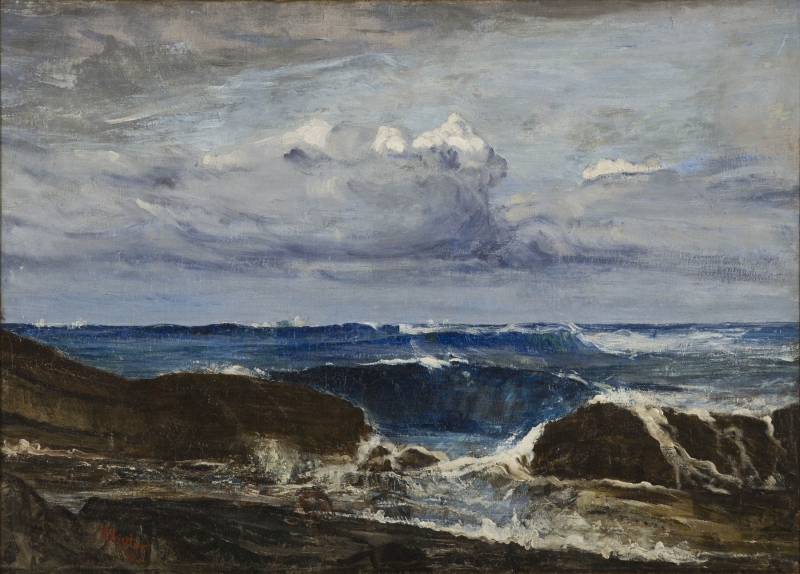Blue and Silver: Blue Wave, Biarritz is signed and dated '1862'.
Whistler worked on several pictures during his stay in Guéthary, Basses-Pyrénées, during October and November 1862, but only Blue and Silver: Blue Wave, Biarritz and A White Note [YMSM 044] survive. 1
Early in October, Whistler described and drew the painting in a letter to Ignace-Henri-Jean-Théodore Fantin-Latour (1836-1904), commenting, 'La grande toile est peutetre assez bien d'arrangement mais ça marche si lentement que j'en suis au desespoir! Il est vrai qu'aujourdhui a été un de mes mauvais jours, et qu'hier j'en pensais mieux.' 2 Translation: 'The big canvas is perhaps well enough planned, but it's going so slowly that I am at the point of despair! It's true that today was one of my bad days, and that yesterday I thought better of it.' Fantin-Latour was enthusiastic and, in reply to Whistler's letter, wrote:
'Eh! bien ton tableau d'après le croquis me parait très bien disposé, les lignes du ciel, de la mer la position des personnages tout cela me parait tres bien, mais très bien en ouvrant la lettre cela m'a fait de suite un bon effet, cette impression d'ornement pittoresque - qui fait qu'un bon tableau parait aussi agreable à l'oeil - à l'envers et dans tout les sens.' 3
Translation: 'Well! judging by the sketch your picture seems to me well-composed, the lines of sky, sea, the position of the figures all that seems very, very well done[,] on opening the letter it struck me immediately, this impression of picturesque ornament that makes a good picture appeal to the eye as well - upside down and any other way up.'
Whistler wrote back, complaining of his difficulties, and describing his paintings as 'grandes esquisses' (large sketches):
'Mon tableau ... traine; je ne travaile pas assez vite ! ... Du reste ces peintures en plein air d'apres nature ne peuvent être que de grandes esquisses … La mer a été immense depuis quelque temps! et j'ai en vain attendu une de la même couleur que celle que j'avais commencé!' 4
Translation: 'My picture ... is dragging; I am not working quickly enough! ... Apart from that these paintings in the open air from nature can only be large sketches. … The sea has been huge for some time! - and I have waited in vain for it to be the same colour as the one on which I started!'
Still, he obviously hoped to complete his pictures, and on 18 October he asked the Paris-based art dealer George Aloysius Lucas (1824-1909) to order two picture frames, one for a 'sea piece of deep tone' and another for a commissioned painting. 5 But Whistler stayed on until, in mid-November, he told Fantin-Latour that he was giving up:
'J'ai eu une chance attroce! - La pluie! la pluie! et la pluie, ou bien le soleil stupide sans nuages, et une mer d'une platitude à vous faire cracher dedans ... et maintenant je me vois forcé d'abandonner ce tableau jusqu'à l'an prochain - je laisserai la toile içi et je reviendrai la finir - Ah mon cher decidement tu as raison - la peinture d'apres nature! on doit la faire chez soi!' 6
Translation: 'I have had terrible luck! - Rain! rain! and rain, or stupid sunshine without any clouds, and sea so flat you want to spit in it ... and now I am going to be forced to give the picture up until next year - I'll leave the canvas here and I'll come back to finish it - Ah, mon cher, you are absolutely right - painting from nature! needs to be done at home!'
He may have planned to return to Guéthary but never did so.
Last updated: 31st December 2020 by Margaret







